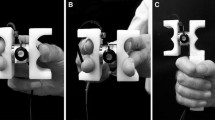Abstract
We studied grip force control when catching a free-falling object with the dominant hand. An instrumented object was dropped either from the subjects’ opposite hand or expectedly from the experimenter’s hand. Following digit-object contact, triggered responses were observed in the load and grip force profiles. The peak rates of load force increase and the peak load forces produced at the time the catching fingers made contact with the object were of similar magnitude for the experimenter- and self-release conditions. However, the peak rates of grip force development and the peak grip forces were more pronounced when the object was dropped by the experimenter. These findings suggest that the prediction of the load magnitude was less precise when the object was dropped from the experimenter’s hand. In addition, a correlation analysis between maximum grip and load force rates revealed a less precise coupling between the force rates in the experimenter-release condition. The time lags between maximum force rates and maximum forces were longer for the experimenter-release than for the self-release condition. These observations may indicate a less precise temporal coupling between grip and load force profiles in the experimenter-release condition. As observed during other manipulative tasks, the co-ordination between grip and load forces is a prerequisite to cope with collision forces when catching free-falling objects. Grip force control during catching is both highly automatic and flexible depending on the predictability of the task.


Similar content being viewed by others
References
Aruin AS, Shiratori T, Latash ML (2001) The role of action in postural preparation for loading and unloading in standing subjects. Exp Brain Res 138:458–466
Bennett DJ, Gorassini M, Prochazka A (1994) Catching a ball: contributions of intrinsic muscle stiffness, reflexes and higher order responses. Can J Physiol Pharmacol 72:525–534
Flanagan JR, Tresilian JR, Wing AM (1994) Grip-load force coupling: a general control strategy for transporting objects. J Exp Psychol Hum Percep Perform 20:944–957
Johansson RS (1996) Sensory control of dexterous manipulation in humans. In: Wing AM, Haggard P, Flanagan JR (eds) Hand and brain. Academic Press, San Diego, CA, pp 381–414
Johansson RS, Westling G (1988) Programmed and triggered actions to rapid load changes during precision grip. Exp Brain Res 71:72–86
Lacquaniti F, Maioli C (1989) The role of preparation and in tuning anticipatory and reflex responses during catching. J Neurosci 9:134–148
Nowak DA, Hermsdörfer J (2003a) Selective deficits of grip force control during object manipulation in patients with reduced sensibility of the grasping digits. Neurosci Res 47:65–72
Nowak DA, Hermsdörfer J (2003b) When motor execution is selectively impaired: control of manipulative finger forces in amyotrophic lateral sclerosis. Motor Control 7:304–320
Serrien DJ, Kaluzny P, Wicki U, Wiesendanger M (1999) Grip force adjustments induced by predictable load perturbations during a manipulative task. Exp Brain Res 124:100–106
Shiratori T, Latash ML (2001) Anticipatory postural adjustments during load catching by standing subjects. Clin Neurophysiol 112:1250–1265
Turrell YN, Li FX, Wing AM (1999) Grip force dynamics in the approach to a collision. Exp Brain Res 128:86–91
Wolpert DM, Flanagan JR (2001) Motor prediction. Curr Biol 11:729–732
Acknowledgement
This research was funded by the European Neurological Society (ENS fellowship stipend to Dennis A. Nowak).
Author information
Authors and Affiliations
Corresponding author
Rights and permissions
About this article
Cite this article
Nowak, D.A., Hermsdörfer, J. Predictability influences finger force control when catching a free-falling object. Exp Brain Res 154, 411–416 (2004). https://doi.org/10.1007/s00221-003-1754-4
Received:
Accepted:
Published:
Issue Date:
DOI: https://doi.org/10.1007/s00221-003-1754-4




